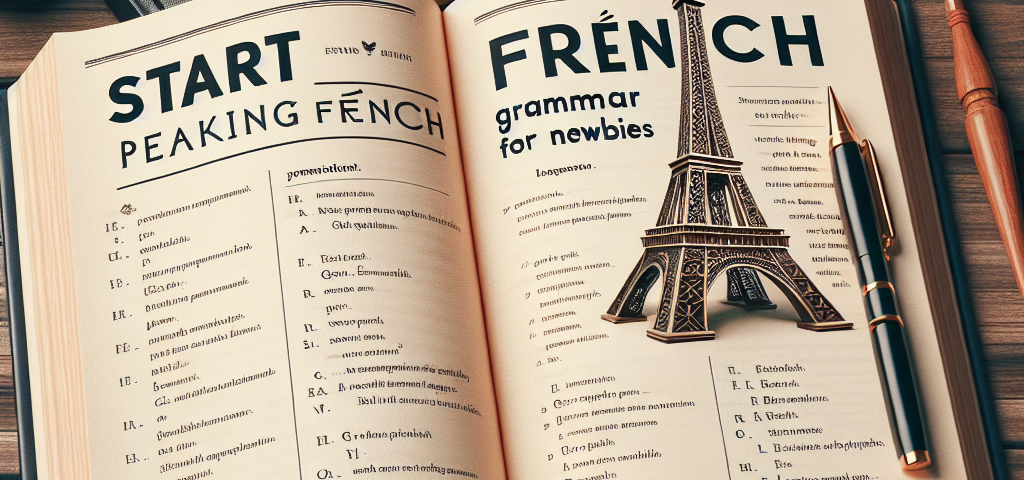
Dive into French: Essential Tools and Resources for Language Learners
May 30, 2025
Learn French Like a Pro: Resources That Actually Work
May 30, 2025
Learning a new language can be an exciting journey, and for many, French is at the top of the list. Known for its elegance and richness, the French language offers a beautiful way to express oneself. However, before diving headfirst into conversation, it’s helpful to grasp some essential grammar rules. Here’s a guide to get you started on your French-speaking adventure.
1. Gendered Nouns
One of the first things newcomers to French must understand is that every noun is assigned a gender: masculine or feminine. This affects the articles and adjectives associated with the noun.
- Masculine nouns typically use the article “le” (the) or “un” (a).
- Feminine nouns use “la” (the) or “une” (a).
Examples:
- Masculine: le livre (the book), un chien (a dog)
- Feminine: la table (the table), une fille (a girl)
Tip:
There are some patterns to identify genders, such as nouns ending in -e often being feminine, but there are exceptions. It’s important to memorize the gender alongside the noun.
2. Articles: Definite and Indefinite
In addition to gender, French nouns are used with definite or indefinite articles. The definite article (“the”) has four forms depending on the gender and number:
- le: masculine singular
- la: feminine singular
- les: plural for both genders
- l’: used before a vowel sound, regardless of gender (e.g., l’arbre)
Indefinite articles (“a” or “an”) include:
- un: masculine
- une: feminine
- des: plural for both genders
Example:
- Le chat (the cat)
- Une voiture (a car)
- Des enfants (children)
3. Conjugation of Verbs
Understanding verb conjugation is crucial in French. Verbs change forms based on the subject pronoun (I, you, he, she, etc.). There are three main groups of regular verbs based on their endings: -er, -ir, and -re.
Example Conjugation: Parler (to speak)
- Je parle (I speak)
- Tu parles (You speak)
- Il/elle parle (He/she speaks)
- Nous parlons (We speak)
- Vous parlez (You speak, formal or plural)
- Ils/elles parlent (They speak)
Tip:
Focusing on common verbs first can help you communicate basic ideas and questions effectively.
4. Subject Pronouns
French sentences usually follow a Subject-Verb-Object structure. Knowing the subject pronouns is essential:
- Je (I)
- Tu (You, informal)
- Il/elle (He/she)
- Nous (We)
- Vous (You, formal or plural)
- Ils/elles (They)
Example:
- Je mange (I eat)
- Nous allons au marché (We are going to the market)
5. Adjective Agreement
Adjectives in French must agree in gender and number with the nouns they modify. This means that a masculine noun will take a masculine adjective, and a feminine noun will take a feminine adjective.
Example:
- Un homme intelligent (an intelligent man)
- Une femme intelligente (an intelligent woman)
- Des hommes intelligents (intelligent men)
- Des femmes intelligentes (intelligent women)
Tip:
Most adjectives have a feminine form that you create by adding -e to the masculine form. For plurals, you generally add -s.
6. Negation
To make a sentence negative in French, you typically use “ne… pas.” The “ne” is placed before the verb, and “pas” follows it.
Example:
- Je parle (I speak) becomes Je ne parle pas (I do not speak).
Note:
In casual spoken French, the “ne” is often dropped, especially in informal settings.
7. Asking Questions
Formulating questions in French can be done in several ways:
-
Inversion: Switch the subject and verb.
- Aime-t-il le chocolat? (Does he like chocolate?)
-
Adding “est-ce que”: This phrase can be placed at the beginning of a statement to turn it into a question.
- Est-ce que tu aimes le chocolat? (Do you like chocolate?)
- Raising your intonation: Simply ask a statement with rising tone at the end.
- Tu aimes le chocolat? (You like chocolate?)
Conclusion
Starting your journey in French may seem daunting, but with a basic understanding of these grammar rules, you’ll be well on your way to forming sentences and engaging in conversations. Remember to practice regularly, embrace mistakes as learning opportunities, and immerse yourself in the language through music, film, and conversation. Bon courage!

